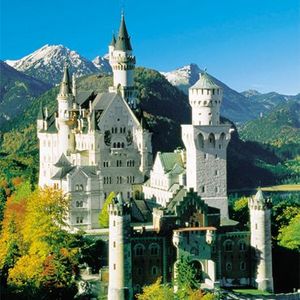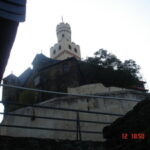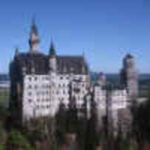I have had the great good fortune to travel to Germany two times. While I have loved almost everything about these trips, I wanted to share my very favorite destination with you – Neuschwanstein Castle in Bavaria (southern Germany). If you are ever in Germany, make sure to visit this castle. Even if you never go to Europe, you can enjoy it vicariously through this article.
The name may baffle you, but you will recognize Neuschwanstein as the castle on which Disney based his castles at Disney Land and Disney World. It looks medieval, but was actually built in the late 1800’s. Its fabulous mountain setting and its many towers and turrets make it everyone’s dream of a “fairy tale castle.
Much of the appeal of Neuschwanstein Castle comes from the history of its owner, King Ludwig II of Bavaria. Ludwig was born in 1845, the son of King Maximilian II. He was a quiet child and enjoyed building things with blocks. When he was just 18, his father died and Ludwig became King of Bavaria. He was still quite shy and had no desire to be King. His main interests were the music of Richard Wagner and architecture. He had three castles built during his lifetime: Neuschwanstein, Linderhof (which is more Baroque-style) and Herrenchiemsee (which is a copy of Paris’ Versailles).
Ludwig was quite eccentric – he often slept during the day and woke at night, insisting that his servants take him on sleigh rides through the countryside in the middle of the night. He ate alone, but requested his table be set for four, because he invited imaginary guests to dinner. Once he had his favorite horse dine with him! Ludwig was also known to make faces at himself in mirrors, put tape on a servant’s head so his brains would not fall out, and request private performances of Wagner’s operas because he didn’t want the public staring at him during a public performance.
In 1886, when he was just 40, Ludwig’s cabinet members decided they had put up with his eccentricities long enough, and they arranged for a doctor to declare him insane. He was arrested at Neuschwanstein Castle and died mysteriously a few days later while taking a walk with his doctor. Both men were found drowned in a shallow lake nearby. The official theory is that Ludwig strangled the doctor and then drowned himself, but to this day no one knows for sure.
The Bavarian people loved Ludwig dearly (and do to this day), referring to him as their “fairy tale king”. The government officials were decidedly less fond of him, calling him “mad King Ludwig”. Which is more accurate? I will leave that for you to decide! Either way though, his castles are a dream to explore.
Neuschwanstein is situated on top of a mountain. You can either hike up, or ride in a wagon drawn by horses. Once you are at the top, you will get into a line (usually a long one – go early or in the “off season”). Inside the castle, you will take a tour of the various rooms. Here are some highlights:
*The Singers’ Hall
This was inspired by a Wagnerian opera and includes a stage and a painted backdrop. Unfortunately, it was never used during Ludwig’s lifetime. Small performances do occur there now.
*The Throne Room
This room features elaborate mosaics depicting Biblical scenes. There is a huge chandelier also. The only thing missing is a throne – none was ever made during Ludwig’s lifetime. The dais remains eerily empty today.
*Ludwig’s bedroom
This room, like all the others, has walls filled with paintings depicting various scenes from Wagner’s operas. The bed is stunning – it has so much carved woodworking that it took 17 woodworkers 4 1/2 years to make it! This is the room which Ludwig was in when he was arrested.
*Grotto
Ludwig’s childlike nature is seen in this artificial cave, built into the castle between the living room and the study. The narrow cave is illuminated with various colors and even has stalactites and a small waterfall! Again, the inspiration was a scene from a Wagnerian opera.
You will tour several other rooms, but I enjoyed these the most. Sadly, much of the castle’s interior was not completed during Ludwig’s life. In spite of Ludwig’s pleas for privacy, Neuschwanstein was opened to tourists just weeks after his death in 1886.
I highly recommend a visit to Neuschwanstein, either in person or through a book. It’s a journey into a real-life fairy tale that is more fascinating than anything the Brothers Grimm ever conceived!




